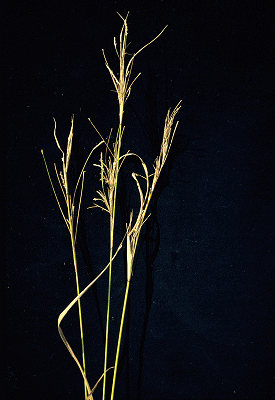 |
 |
|
 |
 |
|

Mnesithea rottboellioides (R.Br.)
de Koning & Sosef
|
Common name
Northern Canegrass
Derivation
Mnesithea Kunth, Révis. Gramin. 1: 153 (1829); in honour of Mnesitheos,
Greek physician and writer on edible plants fide H.T.Clifford, Etymological
Dictionary of Grasses (1996).
rottboellioides- resembling Rottboellia with respect to the inflorescence.
Published in
Blumea 31: 291 (1986).
Common synonyms
Coelorhachis rottboellioides (R.Br.) A.Camus
Habit
Perennial. Culms erect, 100–300 cm tall. Mid-culm nodes glabrous. Lateral
branches branched. Ligule an eciliate or fringed membrane, 1 mm long. Leaf-blades
20–50 cm long, 8–20 mm wide.
Inflorescence
Inflorescences arranged within a synflorescence. Inflorescence terminal and
axillary, subtended by a spatheole, exserted or embraced at base by subtending
leaf. Spatheole linear. Peduncle distinct, widened at apex. Rames few or numerous,
single, smoothly terete, 5–10 cm long. Rhachis fragile at the nodes, semiterete,
glabrous on surface. Rame internodes cuneate, 2–3.5 mm long. Rame internode
tip transverse, crateriform, with simple rim.
Spikelets
Spikelets sunken, in pairs, one sessile and fertile and the other (companion)
spikelet pedicelled. Pedicels columnar, semiterete, 2–3.5 mm long, glabrous.
Companion spikelets developed, male, ovate, 3–4 mm long, as long as fertile.
Companion spikelet glumes winged on keels. Companion spikelet lemmas 2, enclosed
by glumes. Fertile spikelets 2-flowered, comprising 1 fertile floret, lower
floret sterile, upper fertile, without rhachilla extension, ovate, dorsally
compressed, 3–4.5 mm long, 1–1.3 mm wide, falling entire, deciduous
with accessory branch structures. Spikelet callus base truncate, with central
peg, attached transversely.
Glumes
Glumes dissimilar, firmer than fertile lemma. Lower glume elliptic or oblong
or ovate, 100% of length of spikelet, coriaceous or indurate, 2-keeled,
broadly winged on keel, winged near apex or above, midnerve spinulose. Lower
glume surface flat, smooth. Lower glume apex emarginate or obtuse. Upper glume
elliptic or oblong, membranous or coriaceous, 1-keeled. Upper glume apex mucronate.
Florets
Basal sterile florets 1, with palea. Lemma of lower sterile floret elliptic
or oblong, hyaline, obtuse. Fertile lemma elliptic, hyaline. Palea elliptic.
Anthers 2 mm long.
Continental Distribution:
Tropical Asia, Australasia.
Australian Distribution:
Western Australia, Northern Territory, Queensland.
Western Australia: Gardner, Fitzgerald, Dampier. Northern Territory: Darwin & Gulf, Victoria River, Barkly Tableland. Queensland: Cook, Burke, North Kennedy, South Kennedy, Leichhardt.
Classification. (GPWG
2001):
Panicoideae: Andropogoneae
Notes
Native. Widely encountered although only locally common, in grasslands or open
forests of tropical areas. Flowers Dec.–June.

Inflorescence (photo)
© E.Anderson